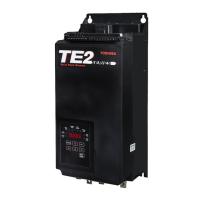Basi
nsta
at
on and Operat
on G
de
T
Ser
es D
ta
olid
tate
o
t
tarters 1
1250A
13 | Page
3.1.3.c Overload Protection During Bypass
When an integral Bypass Contactor is used to shunt power around
the SCRs in the TE Series (as in the TE…-BP version), overload
protection is maintained as long as the TE Series is directly
controlling the contactor. No additional Overload Relay is necessary
for normal operation.
When the Bypass Contactor on a TE…-BP Series has been
selected to be used for Across-the-Line restart (reference section
1.2.3), supplemental overload protection is necessary. For this
application, refer to the External Overload Relay Applications
supplement and wiring diagram in Appendix 4.
3.1.3.d Dynamic Reset Capacity
The TE Series includes the ability to dynamically track the Thermal
Capacity needed for a successful restart after an overload trip. It
averages the Thermal Capacity consumed in the previous three
successful starts, and calculates a Thermal Capacity to Start (viewed
in Function F059). After tripping on Overload, the Thermal Register
must have regained the amount recorded in F059 before a Reset will
be allowed. If the display reads [Inh] when attempting to reset an
overload trip, it is indicating that the starter is Inhibited from being
reset.
Refer to details of Function F071 for information on emergency
override of lockouts such as this.
3.2 NEMA Class Trip Curves
NEMA Class trip curves are based on a common tripping point of 600%
of motor Full Load Amps (FLA). Curves vary by the amount of time
before the unit trips. As an example, a Class 20 curve will trip in 20
seconds at 600% of FLA. The factory default setting of Class 10 will trip
in 10 seconds at 600% of FLA.
3.2.1 Dual Overload Trip Curves
The TE Series Soft Starter provides two separate Overload Trip
Protection Curves, one for starting and one for running conditions. The
starter’s At-Speed detection circuit determines when the motor has
reached full speed. When the At-Speed condition is reached, the
overload trip curve will shift from the Start to the Run level, as
programmed in Functions F003 and F004. See Section 5.6.1 for
programming details.
3.2.2 Starting Overload Trip Curve
During the start mode, Overload Trip Curves are selectable from NEMA
Class 5 through Class 30. The default setting of Class 10 allows
protection for the overload capacity of the soft starter as well as the
motor. Use a higher Trip Class only if nuisance tripping occurs with the
default setting.
Buy: www.ValinOnline.com | Phone 844-385-3099 | Email: CustomerService@valin.com

